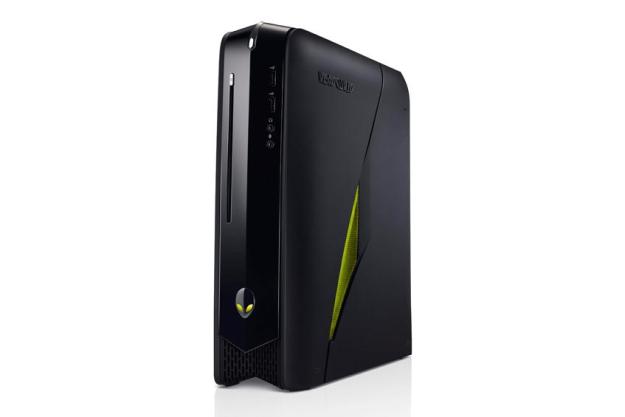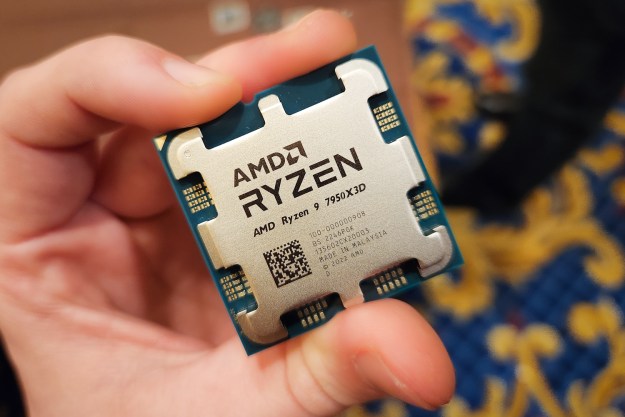
“There is serious gaming power in this relatively tiny box, and the whole thing taken together represents one of the best values out there for high-performance PC gaming.”
- Beautifully compact design
- Lots of power for the price
- USB 3.0 ports and built-in Wi-Fi beat you to the punch on upgrades
- Easy access interior, part-swapping
- Minimally flexible for future upgrades
- More complex than a standalone console
- Hefty power brick will need to be hidden away under some furniture
Dell refreshed the X51, check out our review of the 2013 Alienware X51.
Gaming consoles can do some amazing things, no question, but there’s really no comparing the graphical output and processing power of the Xbox 360 or PlayStation 3 with a proper gaming PC. Certainly not now, more than five years after the current console hardware generation launched. In spite of this, the gaming mainstream continues to stick with consoles. There are a number of reasons for this.
Cost is always a factor; whether you’re going with a pre-built rig or a hand-crafted one, you’re likely going to spend more than triple what you would on a dedicated game console. PCs are also just more complicated to deal with. You can’t typically just plug one into your TV or monitor and start playing games. Physical space is an issue as well. Desktops are big, beastly pieces of hardware, especially when they’re built for gaming. Not always though. Not in the case of the Alienware X51.
This new, compact offering from the Dell-owned
The $949 model packs a lot of processing punch on its own, but is that enough to justify spending three times more than you would on a console for something built to live in your entertainment center? Let’s take a look and see for ourselves.
Enter the Super Xbox
The physical design of the X51 desktop is definitely meant to be one of its selling points. Standing in its vertical oriented (you can also lay it down horizontally), it measures slightly more than 13 inches in height and three inches wide. The late-model Xbox 360 Slims are the same width and only a few inches shorter. You’re looking at a box that is roughly the same size as the original PlayStation 3, only less bulbous. In fact, with the Alienware lighting scheme doing its thing and the X51 laid down in a horizontal orientation, you could be forgiven for mistaking the box at a glance for an original Xbox.
Everything here is designed to be space-conscious. There’s a slot-loading dual-layer DVD burner, which cuts down on the amount of real estate that a (more typically used) tray-loading drive would take up. The front of the unit is glossy black with two USB 2.0 ports and two headphone jacks situated just below the disc drive. There’s also a slim, silver-colored power button at one end that curves around to the side of the box and an alien head Alienware logo (backlit, naturally) that you can actually spin to suit either vertical or horizontal orientations.

You’ll find the rest of the connection points jockeying for position on the back of the X51: four USB 2.0 ports, two USB 3.0 ports, an Ethernet port (there’s also a built-in Wi-Fi card), an HDMI port (built into the motherboard), analog audio I/O ports, and both RCA and S/PDIF digital audio output jacks. The NVIDIA
Gamers will want to take note here: it is far preferable to use the GPU’s video output connectors than it is to use the motherboard’s HDMI port. And no matter what, you’ll very likely need to manually resize your display area to fit your HDTV’s screen. It’s as simple as messing around with a few sliders until you like what you’re looking at, so it’s not a difficult process. You’ll still need more tech know-how than you would plugging in a gaming console, however.
Performing well on a budget
At $949, our review model of the Alienware X51 isn’t exactly cheap, but it still delivers a lot of gaming power compared to the money you’re spending. We sampled a varied cross-section of recent game releases and they all performed admirably with most of their bells and whistles turned on. Battlefield 3 runs smoothly on high settings at 1920 x 1080 on a 40-inch LCD monitor. Crysis 2 on ultra delivered extremely playable frame rates at the same resolution.
Skyrim, NBA 2K12, L.A. Noire, Star Wars: The Old Republic, Batman: Arkham City, Grand Theft Auto IV… all of these default to higher graphics settings in auto-detect tests and perform admirably. They’re not consistently hitting 60fps at a 1080p resolution setting, but the performance is more than just acceptable.
In benchmarking tests, the X51 scored a 3,368 on 3DMark 11’s Performance test and a 2,903 on PCMark 7. This puts the X51 pretty close to the iBuypower Gamer Power BTS11 in terms of both price and performance, though the iBuyPower is packed into a proper, full-sized tower. The X51’s compact size is admittedly a big draw, since this is a gaming computer designed to fit into your media center.
Peeking Under the Hood
Removing just one screw from the rear of the unit allows you to slide off the side cover and access the X51’s innards. It takes a small amount of force, but take care when slide the casing open as there’s a set of wires connecting the covering to the main body of the unit. The overall design of the interior is arrayed out differently than you’d expect from a desktop PC, but that’s to be expected when you’re replacing a proper tower with a shell that is roughly the size of a gaming console.
Kudos then to Alienware for coming up with a compartmentalized design that offers easy access to various components, which either slide or lift out. This is particularly true with the

There is, however, a notable drawback to this tightly contained design. Upgrading parts will require you to adhere to some pretty specific size restrictions. There’s only so much space for a
Along with the hardware, you’ve got a relatively clean installation of Windows 7 Home Premium 64-bit Edition packed in and very little in the way of bloatware to be removed. The standard Alienware suite of command tools is available for tweaking color themes and such, which you can use or not use as it suits you. As with most gaming-oriented PCs, the X51 has a tendency to heat up when you start gaming. The fan never really reached unacceptable volumes, but you’ll still want to leave a good amount of space clear around the unit so it doesn’t cook itself.
All told, the Alienware X51 is one of the best buys out there for a budget-minded PC gamer who’s been raised on console gaming. You’re looking at a relatively easy setup for a powerful system that is capable of running the latest games at higher display settings than you’d get on an Xbox 360 or PlayStation 3, while still delivering the 1080p output that you’ll want in your home entertainment center.
Conclusion
When rumors of a “Steam Box” hardware spec from Valve kicked up earlier this year, it was suggested that the X51 was designed with that spec in mind. Whether or not those rumors were accurate, it’s easy to see why this new Alienware offering would be connected to them. There is serious gaming power in this relatively tiny box, and the whole thing taken together represents one of the best values out there for high-performance PC gaming.
Highs
- Beautifully compact design
- Lots of power for the price
- USB 3.0 ports and built-in Wi-Fi beat you to the punch on upgrades
- Easy access interior, part-swapping
Lows
- Minimally flexible for future upgrades
- More complex than a standalone console
- Hefty power brick will need to be hidden away under some furniture
Editors' Recommendations
- Best gaming PC deals: Lenovo Legion, ASUS ROG, Acer Predator
- The 10 best monitors for 2024: tested and reviewed
- Alienware is playing coy with its two new QD-OLED monitors
- Alienware just invalidated its own high-end esports monitor
- Acer’s new Predator Orion X is an RTX 4090 desktop I might actually buy


